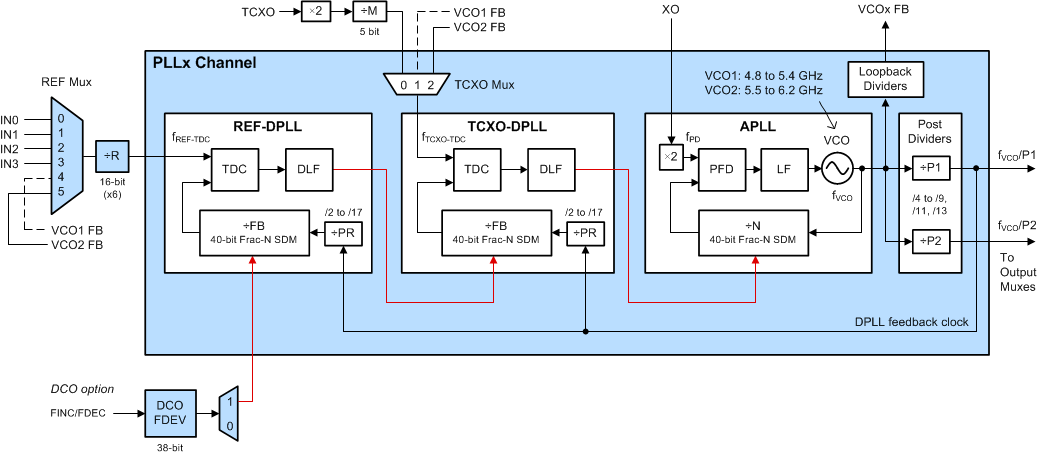ZHCSHN9A February 2018 – April 2018 LMK05028
PRODUCTION DATA.
- 1 特性
- 2 应用
- 3 说明
- 4 修订历史记录
- 5 说明 (续)
- 6 Pin Configuration and Functions
- 7 Specifications
- 8 Parameter Measurement Information
-
9 Detailed Description
- 9.1 Overview
- 9.2 Functional Block Diagrams
- 9.3
Feature Description
- 9.3.1 Oscillator Input (XO_P/N)
- 9.3.2 TCXO/OCXO Input (TCXO_IN)
- 9.3.3 Reference Inputs (INx_P/N)
- 9.3.4 Clock Input Interfacing and Termination
- 9.3.5 Reference Input Mux Selection
- 9.3.6 Hitless Switching
- 9.3.7 Gapped Clock Support on Reference Inputs
- 9.3.8 Input Clock and PLL Monitoring, Status, and Interrupts
- 9.3.9
PLL Channels
- 9.3.9.1 PLL Frequency Relationships
- 9.3.9.2 Analog PLL (APLL)
- 9.3.9.3 APLL XO Doubler
- 9.3.9.4 APLL Phase Frequency Detector (PFD) and Charge Pump
- 9.3.9.5 APLL Loop Filter
- 9.3.9.6 APLL Voltage Controlled Oscillator (VCO)
- 9.3.9.7 APLL VCO Post-Dividers (P1, P2)
- 9.3.9.8 APLL Fractional N Divider (N) With SDM
- 9.3.9.9 REF-DPLL Reference Divider (R)
- 9.3.9.10 TCXO/OCXO Input Doubler and M Divider
- 9.3.9.11 TCXO Mux
- 9.3.9.12 REF-DPLL and TCXO-DPLL Time-to-Digital Converter (TDC)
- 9.3.9.13 REF-DPLL and TCXO-DPLL Loop Filter
- 9.3.9.14 REF-DPLL and TCXO-DPLL Feedback Dividers
- 9.3.10 Output Clock Distribution
- 9.3.11 Output Channel Muxes
- 9.3.12 Output Dividers
- 9.3.13 Clock Outputs (OUTx_P/N)
- 9.3.14 Glitchless Output Clock Start-Up
- 9.3.15 Clock Output Interfacing and Termination
- 9.3.16 Output Synchronization (SYNC)
- 9.3.17 Zero-Delay Mode (ZDM) Configuration
- 9.3.18 PLL Cascading With Internal VCO Loopback
- 9.4 Device Functional Modes
- 9.5 Programming
- 9.6 Register Maps
- 10Application and Implementation
- 11Power Supply Recommendations
- 12Layout
- 13器件和文档支持
- 14机械、封装和可订购信息
9.2.2 3-Loop Mode
In 3-loop mode, the TCXO/OCXO source determines the free-run and holdover frequency stability and accuracy, and the XO source determines the output phase noise and jitter performance over the 12-kHz to 20-MHz integration band. 3-loop mode allows the use of a cost-effective, low-frequency TCXO/OCXO (such as 10 or 12.8 MHz) to support standards-compliant frequency stability and low loop bandwidth (≤10 Hz) required in synchronization applications like SyncE and SONET/SDH.
The principle of operation for 3-loop mode is as follows. After power-on reset and initialization, the APLL locks the VCO to the external XO input clock and operates in free-run mode. Once the external TCXO/OCXO input clock is detected, the TCXO-DPLL begins lock acquisition. The TCXO TDC compares the phase of the TCXO/OCXO clock and the TCXO FB divider clock (from the VCO) and generates a digital correction word corresponding to the phase error. The correction word is filtered by the TCXO DLF, and its output controls the APLL N divider SDM to pull the VCO frequency until it is locked to the TCXO/OCXO clock. After a valid reference input is selected, the REF-DPLL enters lock acquisition mode. The REF TDC compares the phase of the selected input clock and the REF FB divider clock (from the VCO) and generates a digital correction word. The correction word is filtered by the REF DLF, and its output controls the TCXO FB divider SDM which translates to a frequency offset to the TCXO TDC. This frequency correction propagates through the TCXO-DPLL which then controls the APLL N divider SDM to pull the VCO frequency until it is locked to the selected reference input clock.
If DCO mode is enabled on the REF-DPLL, a frequency deviation step value (FDEV) can be programmed and used to adjust (increment or decrement) the REF FB divider SDM, where the frequency adjustment effectively propagates through the 3 nested loops to the VCO output.
To ensure proper loop stability in 3-loop mode, the REF-DPLL has the lowest loop bandwidth (BWREF-DPLL ≤ 80 Hz, typical), the TCXO-DPLL has a higher loop bandwidth (BWREF-DPLL × 50 ≤ BWTCXO-DPLL ≤ 4 kHz), and the APLL has the highest bandwidth (BWAPLL is approximately 500 kHz typical).
When operating in 3-loop mode and all reference inputs to the REF-DPLL are lost, the PLL channel will enter holdover mode and operate similar to 2-loop TCXO-DPLL mode.
 Figure 20. 3-Loop Mode with DCO Option
Figure 20. 3-Loop Mode with DCO Option